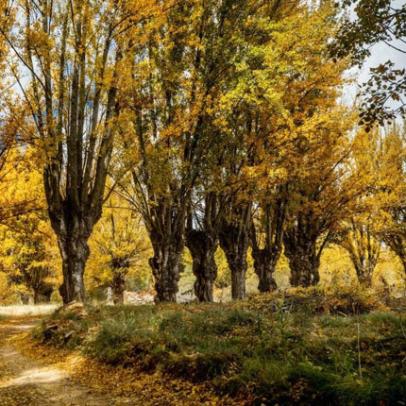Pollarded poplars, Navarrete del Río

Next to the road between Barrachina and Navarrete de Río Navarrete del Río
For centuries, the inhabitants of villages in the middle of the province of Teruel have maintained a special relationship with the poplars that grow on the river banks. From these trees they obtained timber for building (straight beams), firewood, and food for livestock (fresh leaves and shoots). To achieve this, they pollarded the poplars, which consisted of cutting the high branches of the tree so that the trunk would grow broad and strong. This gave the trees their characteristic appearance. Because of the wide ecological distribution of poplar, this way of pruning them must have been quite widespread across the north of the Iberian Peninsula, and it is still carried out in such different countries as England, Hungary and Turkey.
If they are not pollarded, black poplars (Populus nigra) can reach a height of 30 or 40 metres. When they are young, their bark is light-coloured and smooth and as they grow old, it becomes darker and fissured. It is a fast-growing tree, and for that reason it was traditionally used industrially to make paper. In this area, pollarded poplars normally appear in rows on the sides of fields with irrigation channels, ravines and rivers, because they were planted by the farmers, who selected the specimens that produced the straightest branches or that best supported pollarding.
- Access by car: pollarded poplars are a characteristic element of the Jiloca region and can be seen in most villages. Many specimens can be seen next to the road between Barrachina and Navarrete de Río, in the valley of the River Pancrudo. We suggest visiting a lovely spot by the river with one of the largest groups of pollarded poplars in the area. It is at the confluence of the Regajo Ravine with the River Pancrudo, and can be reached on the A-1508 road, 2km before Navarrete del Río (from Barrachina). Immediately after crossing a small bridge over the stream, take an earth track on the left, where you can park your car in the shade of a row of poplars, and continue along a pleasant path to the River Pancrudo.
- Access for people with limited mobility: there are no infrastructures adapted for people with limited mobility.
- Legal protection: it does not form part of any Protected Natural Area.
- Seasonality: it can be visited at any time of the year, since its appearance changes with the seasons.
- Recommendations, what to see and do: stroll along the banks of the River Pancrudo or turn off for a few metres to Cutanda to explore its castle and the history of one of the most decisive battles in medieval history.
Rev. PAB: 08.05.23

